So What Do You Do All Day?
Freiburg, May 04, 2017
So what do Mommy and Daddy actually do all day long after they have gone off to their jobs? MiKi Day takes place every two years. It's the day when University of Freiburg employees bring their children to work. And so the little ones get to know more than just their parent's work station, they are taken on a tour of the entire university. This time it even features fire, flames and the magic of a green screen.
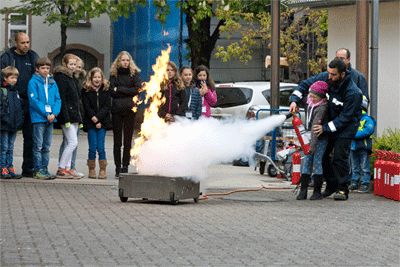
Fotos: Jürgen Gocke
Helena should actually have already been at school before eight o'clock this morning. But this is an exception and she enjoys a leisurely start to her day. Today, she's allowed to go to work with her mother, Sophia Noz. The third-grader has taken a special day off from school to do this. "She does something to do with projects," Helena explains. Her description of her mother's career is on target. Noz is responsible for organizing projects involving third party funds at the Freiburg Academy of Continuing Education. Today Helena is getting the opportunity to find out more about where her mother works.
The University of Freiburg's Family Services Office sent out invitations to MiKi Day at the end of April 2017. MiKi stands for Mitarbeiter-Kind in German or Employee-Child in English. "We want to make it apparent how much importance we place on the family and the compatibility of family life and careers," says Ellen Biesenbach, who heads Family Services. Initiated by the Staff Equal Opportunity Representative, the first MiKi Day was held in 2004. Since then it has taken place every two years. This year, it is being organized in cooperation with the Equal Opportunity Office. The boys and girls may accompany their parents to work on this day and, incidentally, should come away with an idea of what career opportunities are open to them – including those beyond strictly established gender roles.

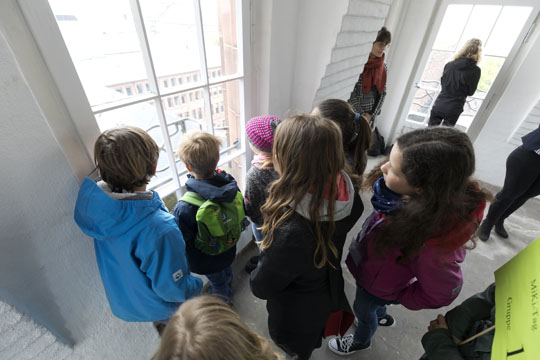 What used to be a jail is a small museum today – the karzer at the University of Freiburg.
What used to be a jail is a small museum today – the karzer at the University of Freiburg.
Photos: Jürgen Gocke
Storytelling ability is in demand
"I want to become a journalist," announces Helena and begins her interrogation of Elvira Zähringer. Her mother's colleague has taken Helena along to the Central Mail Room in nearby Collegiate Building III. The university internal mail system is a science in and of itself. Zähringer knows how to get the point across. "What's postage?" Helena asks. She follows with "How often do you go to the post office?" Helena is not bored at all, even though she didn't get one of the 30 highly-prized places in the MiKi Day program that Biesenbach and her team have organized. Even a visit to the karzer, which used to be the university jail, is on the agenda.
The right place for the little journalist would be the Media Center of the University Library, another stop on the tour. That is where the student editorial offices of uniCross are located. There, students produce material for the university's own radio and television programs and its on-line magazine. Sebastian is a young man with a wonderful presenter's voice. He has a real knack for storytelling that has seen him qualify for Germany's science and informational program for children, Sendung mit der Maus. He shows youngsters in the studio how many buttons he has to push when he's preparing a radio broadcast. He's choosing one of seven thousand song titles, and between the tunes he delivers reports about the university or news supplied by Deutschlandfunk, or receives calls from listeners.
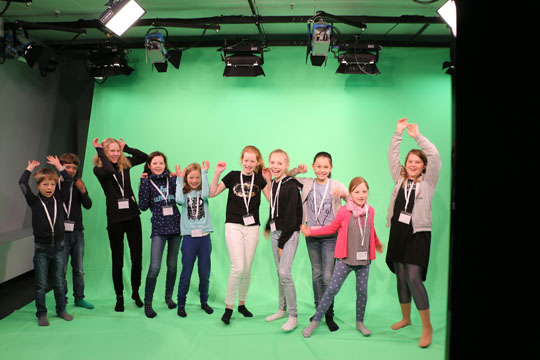
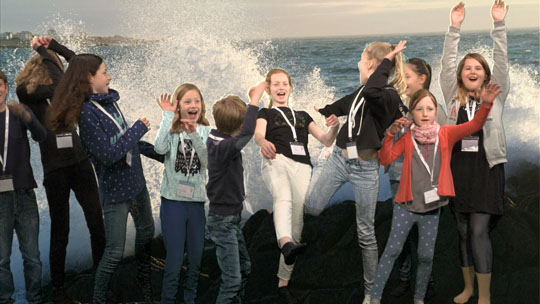 The perfect wave: Children learn the tricks of producing television.
The perfect wave: Children learn the tricks of producing television.
Photos: Sarah Posselt-Böhm/uniCROSS
Perfect illusion
Amelie Wernet would "spend every day here" and "become a presenter." She has just done some practicing and recorded a lead-in for the afternoon radio show Uni-FM am Nachmittag. And together with three other children, she performed a short radio play by Sebastian called Der Mystery-Hund, or The Mystery Dog. The role of Ida – what a coincidence – was placed by eight-year-old Ida ("I'm even called Ida!"). The whole thing was really scary, particularly when Sebastian added the background sounds that accompany the story: rolling thunder, a barking, panting dog and a honking horn.
At the television studio in the Media Center the kids had already seen how beautiful illusions could be conjured up from the most mundane realities. Choreographed by the managing editor of Uni-TV, Andreas Nagel, the group romped around in front of a green background. In the end, they can be seen on a sandy beach, beneath palm trees. Behind them, an enormous wave just keeps on growing and a monstrous monitor lizard slithers closer and closer. Even though they had to act terrified, one or two of them couldn't suppress embarrassed grins. The illusion was finally just right when the Lion King muscled in and allowed them to scratch his majestic mane. Amidst all the drama, there was a lesson for the MiKis, too. The deputy director of the Media Center, Wolfgang Krause, warned, "Don't believe everything you see, for example, on Youtube. A lot of it isn't real."
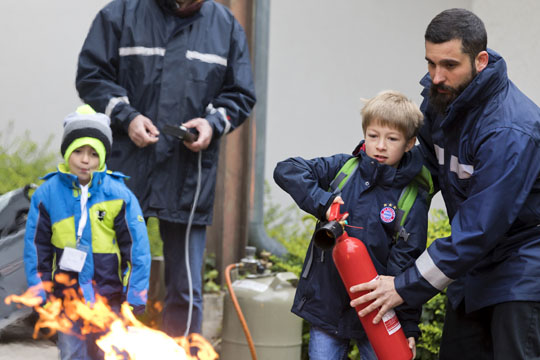
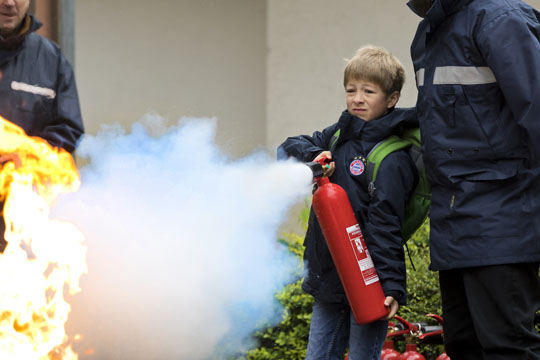 Easy fire extinguishing – first remove the yellow safety tab, then push down hard on the red button.
Easy fire extinguishing – first remove the yellow safety tab, then push down hard on the red button.
Photos: Jürgen Gocke
Firefighting for beginners
Roland Birmele and Benjamin Schätzle are as real as real can be. The children simply call them Roland and Benni. Both men work in the Safety Office – which is responsible for, among other things, fire safety at the university. Biesenbach emphasizes that the issue is a really important and current one. The men are waiting in the courtyard of the Institute of Forest Sciences on Werthmannstraße. In front of them is a glass dish full of burning tea lights, around which they have set up different types of fire extinguishers. "We practice with your parents," explains Schätzle, "so they learn what they have to do when there's a fire." The children are going to find out the same thing now. Schätzle's five-year-old son, Marlon, shows them how to use a foam fire extinguisher with a practiced hand. His peers follow him one after the other. First you remove the gold safety tab, then push down hard on the red button – the trigger for mixing the extinguishing foam in the canister.
The experts then take a bit of dry ice cooled to a chilly minus 56 degrees Celsius out of a crate. Schätzle warns, "Whatever you do, don't touch it!" Snow, by contrast, at around zero degrees, is child's play. When they place the dry ice in a glass of water, thick, smoky clouds billow up. As soon as it comes into contact with the tea lights, all flames are extinguished. So what makes it work? "The smoke takes all the air from the fire," explains one of the safety specialists. But there's an easier way. Birmele whips up a raging fire in a blue pot that is filled with paraffin. All you have to do is put a cover on the pot that fits, and the fire is smothered. It's a method that's worth copying when a pan full of oil catches fire in the kitchen. The children practice.
Amelie doesn't want to get near it. Her on-screen courage is gone. Real fire doesn't seem to be her element. The best thing for her to do is to follow Schätzle's advice to go home and see if smoke alarms are installed in all the children's rooms and living areas. He has a few of the detectors with him and shows the children what they look like. Most of the kids are already clued in. Their parents should brace themselves for what could happen if the fire safety devices aren't where they should be at home.
Anita Rüffer
Document Actions
